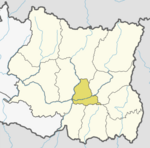Pakhribas Municipality
Pakhribas पाख्रिवास | |
|---|---|
 Pakhribas Bazaar | |
| Coordinates: 27°02′N 87°17′E / 27.04°N 87.29°E | |
| Country | |
| Province | Koshi |
| District | Dhankuta |
| Wards | 10 |
| Established | 2 December 2014 |
| Government | |
| • Mayor | Mr. Brish Bahadur Rai (NCP) |
| • Deputy Mayor | Ms. Devkala Paudel Timsina (NCP) |
| Population (2011) | |
| • Total | 22,078 |
| Time zone | UTC+5:45 (NST) |
| Postal code | 56809 |
| Area code | 026 |
| Website | www |
Pakhribas (Nepali: पाख्रीबास नगरपालिका) is an urban municipality that is one of three urban municipalities located in Dhankuta District of Province No. 1 of Nepal. The municipality was established on 2 December 2014 as a merger of the VDCs of Pakhribas, Sanne, Phalate, Ghorlikharka and Muga.[1]
When the Government of Nepal decided to reduce the local level body in 753 units, all previous VDCs nullified and merged with existing municipalities (some instead created new municipalities), so Chungmang VDC merged with Pakhribas on 10 March 2017.[1]
The total area of the municipality is 144.29 square kilometres (55.71 sq mi) and the total population of the municipality is 22,078 as of the 2011 Nepal census. The municipality is divided into a total of 10 wards.[2]
History
[edit]Pakhribas was a village development committee in Dhankuta District in the Kosi Zone of the Eastern Development Region before 2014. At the time of the 1991 Nepal census, it had a population of 4508 people living in 890 individual households.[3] One story says that Pakhribas got its name from a Pakhri tree which used to stand at the center of the present day Pakhribas Bazaar some decades ago. The porters, transporting goods to Bhojpur and Sankhuwasabha, usually rested under the Pakhri tree and referred to the tree as their baas (lodge) for the night. Hence, the name Pakhribas. Pakhribas has 9 schools, among which three are private schools(Sheetala Devi English Secondary School at Pakhribas-7, Sayapatri English Medium School and Dibyajyoti English School at Pakhribas-3). Jalapa Devi Higher Secondary School provides higher education in science, humanities and arts faculty. Jalapa also has CTEVT annexed sub-overseer course. Pakhribas has three prominent Hindu shrines, one Buddhist monastery and two churches. The churches belong to the Protestant faith. Aashish Church situated in Pakhribas-8 is supposed to be the first of its kind in the Free Presbyterian faith.[4]
Climate
[edit]| Climate data for Pakhribas, elevation 1,680 m (5,510 ft), (1976–2005) | |||||||||||||
|---|---|---|---|---|---|---|---|---|---|---|---|---|---|
| Month | Jan | Feb | Mar | Apr | May | Jun | Jul | Aug | Sep | Oct | Nov | Dec | Year |
| Mean daily maximum °C (°F) | 14.4 (57.9) | 16.3 (61.3) | 20.5 (68.9) | 23.8 (74.8) | 24.1 (75.4) | 24.0 (75.2) | 23.3 (73.9) | 23.5 (74.3) | 23.0 (73.4) | 21.7 (71.1) | 19.1 (66.4) | 15.9 (60.6) | 20.8 (69.4) |
| Mean daily minimum °C (°F) | 4.9 (40.8) | 6.4 (43.5) | 9.9 (49.8) | 12.8 (55.0) | 14.7 (58.5) | 17.0 (62.6) | 17.5 (63.5) | 17.4 (63.3) | 16.3 (61.3) | 13.2 (55.8) | 9.5 (49.1) | 6.4 (43.5) | 12.2 (53.9) |
| Average precipitation mm (inches) | 14.9 (0.59) | 14.5 (0.57) | 25.8 (1.02) | 61.0 (2.40) | 150.1 (5.91) | 261.7 (10.30) | 398.1 (15.67) | 344.0 (13.54) | 194.7 (7.67) | 63.4 (2.50) | 12.9 (0.51) | 12.9 (0.51) | 1,559.8 (61.41) |
| Source: Agricultural Extension in South Asia[5] | |||||||||||||
Demographics
[edit]At the time of the 2011 Nepal census, Pakhribas Municipality had a population of 22,078. Of these, 53.8% spoke Nepali, 14.4% Tamang, 13.4% Magar, 8.8% Rai, 3.0% Bantawa, 1.3% Phangduwali, 0.9% Gurung, 0.7% Limbu, 0.7% Yakkha, 0.6% Newar, 0.5% Nachhiring, 0.4% Athpare, 0.4% Maithili, 0.2% Sherpa, 0.1% Bhujel, 0.1% Dungmali, 0.1% Hindi, 0.1% Sampang, 0.1% Sign language and 0.2% other languages as their first language.[6]
In terms of ethnicity/caste, 27.2% were Chhetri, 16.4% Rai, 16.0% Tamang, 13.9% Magar, 5.8% Hill Brahmin, 4.7% Kami, 3.6% Newar, 2.4% Damai/Dholi, 2.0% Gharti/Bhujel, 2.0% Gurung, 1.9% Sarki, 1.6% Sanyasi/Dasnami, 0.7% Limbu, 0.4% Aathpariya, 0.3% Sherpa, 0.2% Yakkha, 0.1% Bantawa, 0.1% Dhunia, 0.1% Teli, 0.1% other Terai, 0.1% Yadav and 0.5% others.[7]
In terms of religion, 59.8% were Hindu, 26.3% Buddhist, 12.8% Kirati, 1.0% Christian and 0.2% others.[8]
In terms of literacy, 72.2% could read and write, 2.4% could only read and 25.4% could neither read nor write.[9]
Education
[edit]- College of Natural Resources Management (CNRM)
- Ram Madhyamik Biddhyalay, Muga
- Jalapa Madhyamik Biddhyalay, Pakhribas
- Amar Madhyamik Biddhyalay, Phalate
Divisions
[edit]Pakhribas Municipality is divided into different formal VDCs.
| No. | Type | Name |
|---|---|---|
| 1 | Formal VDC | Muga |
| 2 | Formal VDC | Pakhribas |
| 3 | Formal VDC | Chunwang |
| 4 | Formal VDC | Sanne |
| 5 | Formal VDC | Hathikharka |
| 6 | Formal VDC | Phalate |
References
[edit]- ^ a b "संक्षिप्त परिचय". www.pakhribasmun.gov.np. Pakhribas Municipality. Retrieved 30 May 2018.
- ^ "स्थानीय तहहरूको विवरण". www.mofald.gov.np. MoFALD. Archived from the original on 31 August 2018. Retrieved 30 May 2018.
- ^ "Nepal Census 2001". Nepal's Village Development Committees. Digital Himalaya. Retrieved 24 November 2008.
- ^ "Pakhribas". Archived from the original on 17 October 2012. Retrieved 10 August 2012.
- ^ "TEMPORAL AND SPATIAL VARIABILITY OF CLIMATE CHANGE OVER NEPAL (1976-2005)" (PDF). Agricultural Extension in South Asia. Archived from the original (PDF) on 13 October 2023. Retrieved 14 October 2023.
- ^ NepalMap Language [1]
- ^ NepalMap Caste [2]
- ^ NepalMap Religion [3]
- ^ NepalMap Literacy [4]
External links
[edit]![]() Media related to Pakhribas at Wikimedia Commons
Media related to Pakhribas at Wikimedia Commons


 French
French Deutsch
Deutsch

